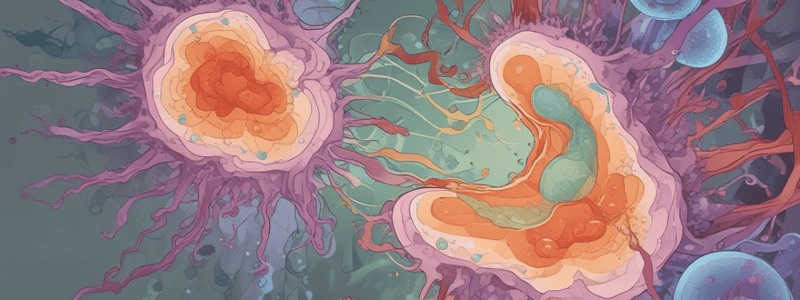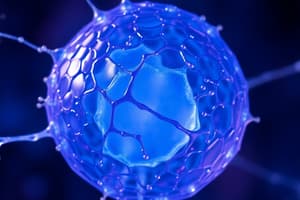Podcast
Questions and Answers
What is the topic of Section 04?
What is the topic of Section 04?
- Cartilage Tissue
- Cytology 1
- Epithelial Tissues (correct)
- Nervous Tissue
How many sections are there in the provided content?
How many sections are there in the provided content?
- 9
- 10 (correct)
- 8
- 11
What comes after Cytology 3 in the content?
What comes after Cytology 3 in the content?
- Muscle Tissue
- Cartilage Tissue
- Connective Tissue (correct)
- Epithelial Tissues
What is the topic of Section 07?
What is the topic of Section 07?
What is the title of Exam One?
What is the title of Exam One?
What topic is covered in Section 08?
What topic is covered in Section 08?
What is the topic of Section 01?
What is the topic of Section 01?
What topic is covered in Section 09?
What topic is covered in Section 09?
What is the main characteristic of prokaryotic cells?
What is the main characteristic of prokaryotic cells?
What is the function of the nuclear envelope?
What is the function of the nuclear envelope?
What is the feature of eukaryotic cells that allows them to have different structures and functions?
What is the feature of eukaryotic cells that allows them to have different structures and functions?
What is the component of the nucleus that is responsible for stabilizing the nuclear envelope?
What is the component of the nucleus that is responsible for stabilizing the nuclear envelope?
What is the term for the fluid inside the nucleus?
What is the term for the fluid inside the nucleus?
What is the function of the nuclear pores?
What is the function of the nuclear pores?
What is the term for the process by which cells become specialized in structure and function?
What is the term for the process by which cells become specialized in structure and function?
What is the characteristic of the outer membrane of the nuclear envelope?
What is the characteristic of the outer membrane of the nuclear envelope?
What is the primary function of the nucleus?
What is the primary function of the nucleus?
What is the term for the DNA found in the nucleus?
What is the term for the DNA found in the nucleus?
Flashcards are hidden until you start studying
Study Notes
Cytology 1
- Human cells can be classified into two main types: prokaryotic cells and eukaryotic cells (human cells).
- Prokaryotic cells are unicellular, lack a nucleus, and have no organelles.
- Eukaryotic cells (human cells) are multicellular, form tissues, have a nucleus, and have organelles.
Nucleus
- The nucleus is the command center of the cell.
- It stores genetic material, coordinates all cell activities (growth, metabolism, protein synthesis, cell division), and has molecular machinery.
- The nucleus has four main components: nuclear envelope, nuclear pores, nucleoplasm, and chromatin.
Nuclear Envelope
- The nuclear envelope consists of two membranes: inner and outer.
- The inner membrane has a nuclear lamina that stabilizes the envelope.
- The outer membrane is continuous with the rough endoplasmic reticulum (rER).
- There is a perinuclear space between the two membranes, continuous with rER.
Nuclear Pores
- Nuclear pores regulate the movement of ions and small molecules through simple diffusion between the nucleoplasm and cytoplasm.
Nucleoplasm (Karyoplasm)
- Nucleoplasm is a viscous fluid.
- It is the region inside the nuclear envelope where the chromatin is located.
Chromatin
- Chromatin consists of DNA.
- Human cells have 46 chromosomes: 22 pairs of autosomes in somatic cells (diploid, 2n) and 22 autosomes in gametes (haploid, n).
Studying That Suits You
Use AI to generate personalized quizzes and flashcards to suit your learning preferences.




